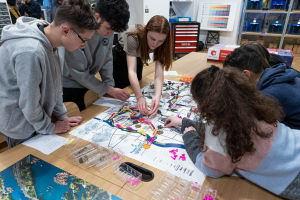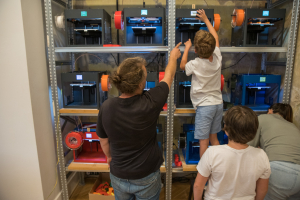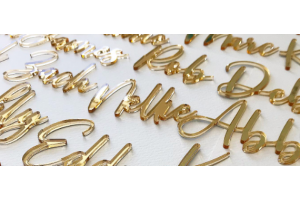Falcon Robotics Case Study
Learn How the Robotics Team at Carl Hayden High School Uses 3d Printing to Push the Boundaries of Stem Learning – Mastering the Skills That Ensure Success in a Rapidly Changing World.
High school robotics teams have never been more popular, and perhaps none are more impressive or well known as the talented crew of 14 - 18 year old students in Phoenix, Arizona that make up Falcon Robotics. Led by the inspiring coach Faridodin “Fredi” Lajvardi, a Marine Science teacher at Carl Hayden High School, Falcon Robotics was catapulted to notoriety in 2004 when they competed as underdogs against high schools and universities to win a national championship.
“Falcon Robotics works sort of like a small company” coach Fredi explains. “Different teams collaborate to design things like navigation software or propulsion systems, solving smaller problems, then fit them together to solve the broader challenges set out by the competition.” With access to reliable and intuitive MakerBot 3D printers in their growing makerspace, this team is able to learn new skills while prototyping robots at a breakneck pace.

Shop Class Used to Build Spice Racks – Now Robotics Class Prototypes Drone Submarines.
Dividing into 3D design, mechanical, software, and marketing teams, the club is equipped with a computer lab and a makerspace that sports a CNC machine and 3 MakerBot printers. Year after year, they continuously iterate on their robosub, HABOOB (Arabic for sandstorm), and improve on its ability to perform different autonomous, underwater tasks.
Before they had 3D printers, their various robot parts had to be made from metal at a local machine shop or outsourced to a 3D printing service. The parts worked, but outsourcing the creation of their designs didn’t give students the level of hands-on experience, ownership, and feedback they needed. Plus, outsourcing for metal or 3D printed parts was expensive, took weeks, and was unforgiving to making adjustments on different iterations.
Once students were able to make parts in-house, they were shocked by how easily and quickly their MakerBot printers could deliver physical objects. Remarking on how that change affected the team’s learning outcomes, Fredi elaborates that “the reduction in time and skill needed to create objects increased the students’ learning cycles. They are able to jump right in again and design modifications or go on to new challenges.”
Speed is critical in engineering sprints like robotics competitions, and access to MakerBot printers enabled Falcon Robotics to fail early, learn from their mistakes, and fix them fast – the same process that makes R&D projects successful in industries from aerospace to consumer product design. Fully utilizing MakerBot printers accelerates the prototyping and design cycle in the same way it accelerates student learning.

Problem Solving Is the Goal, 3d Printers Are the Tools, Robotics Is Just the Medium
The HABOOB is a vehicle for various learning styles and STEM objectives. Designing an effective torpedo launcher isn’t about training the team for specific careers, it’s about training them for any and every career. There’s CAD involved in designing a torpedo, physics in figuring out its center of gravity and buoyancy, but the true lesson is in knowing how to approach a problem and how to point all of your grit, skills, and resources in the right direction until you solve it. Fredi summarizes it well, noting that “the interpersonal and analytical skills they build upon in this club are the kind that will carry them to success in any job, any industry.”
3D printing is an invaluable tool for improving student engagement and revealing their potential as dynamic thinkers. At first, team Falcon’s torpedoes were poorly balanced with bad hydrodynamics and an unreliable launching mechanism. By using a variety of MakerBot printers, they were able to test and refine designs in only a week, solving a challenge that would have otherwise taken more than a month.
The team’s 3D printers speak to their unlimited potential, but they’re also a symbol of their adaptive mindset. From the internal lattices that organize the sub’s onboard electronics to the external pieces that support its battery and propulsion, the HABOOB is designed to be easily modified so that when team Falcon gets next year’s challenge they can 3D print new, tailored parts without a complete overhaul.
Intuitive software and reliable hardware are essential to a makerspace and are especially important to a robotics team that’s under the gun to build a submarine. MakerBot is leading the way by innovating shorter learning curves and simpler workflows, all things essential for schools to implement and get the full value from their 3D printers.
With Makerbot, Classes Learn Like Students but Perform Like Professionals
It’s easy to be in awe of engineers tackling the technical challenges of autonomous vehicle design, but when those engineers are 10th-graders in high school, it’s downright impressive.
With MakerBot solutions, Falcon Robotics is able to learn faster, enhance their STEM skills, and learn broader problem solving skills – all while tackling professional level rapid prototyping and engineering.
MakerBot is proud to make products that enable this talented team to transform their ideas into innovations without fear of failure. Whether you’re an award winning high school robotics team, or a teacher looking to inspire your students, MakerBot has a solution for you.


